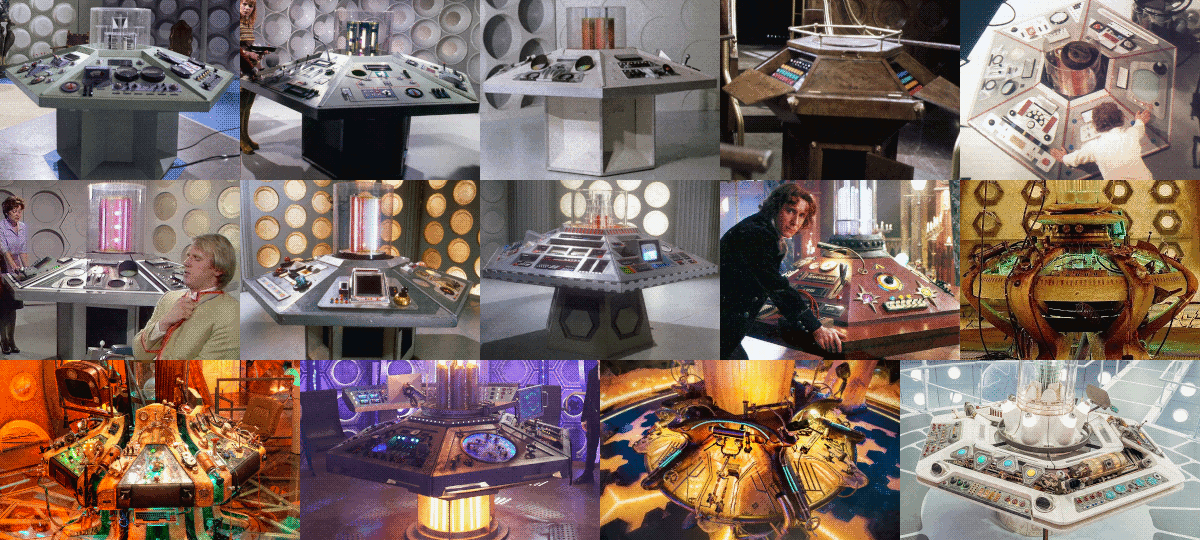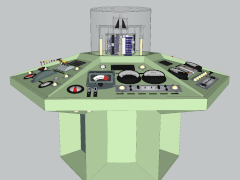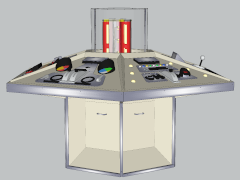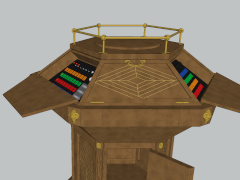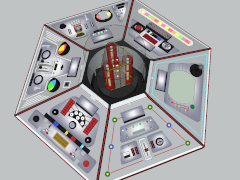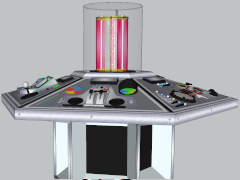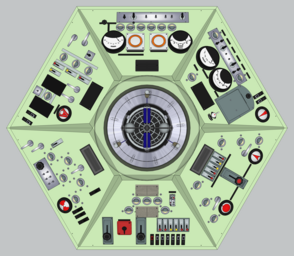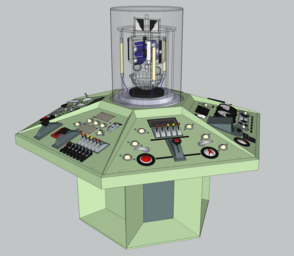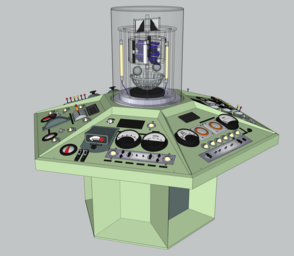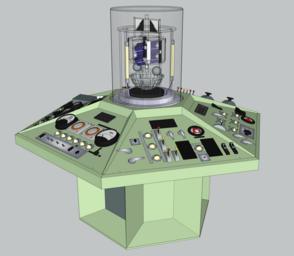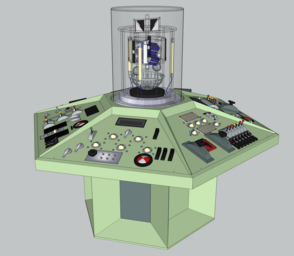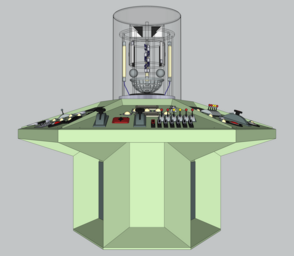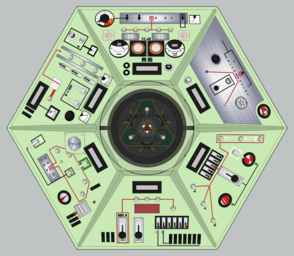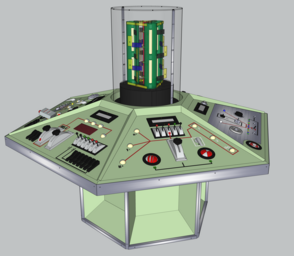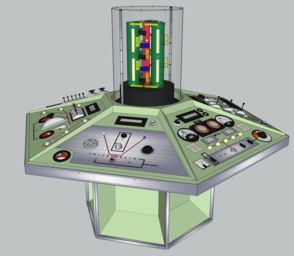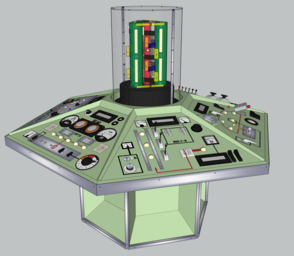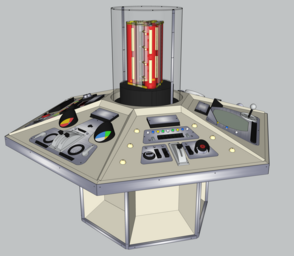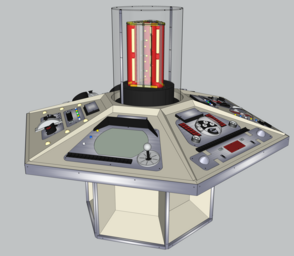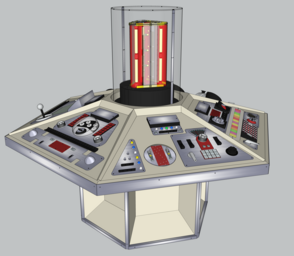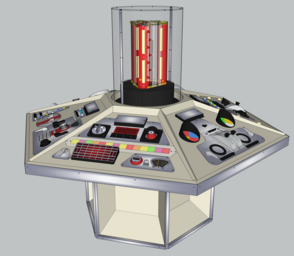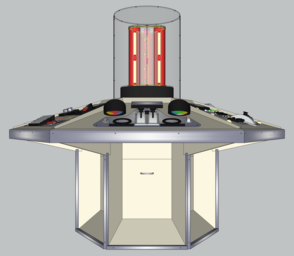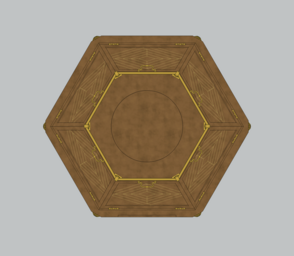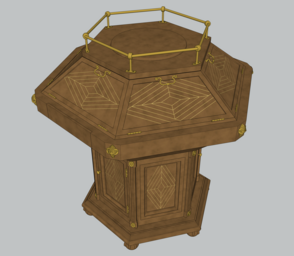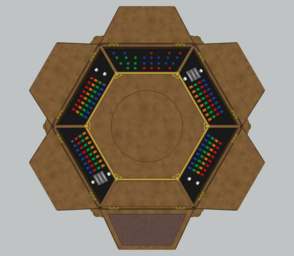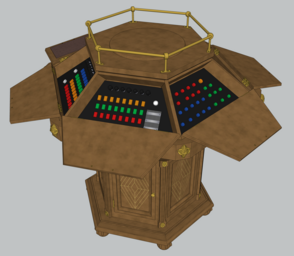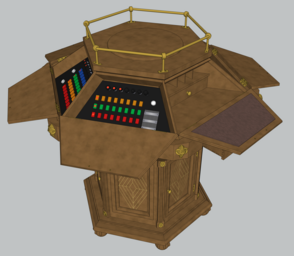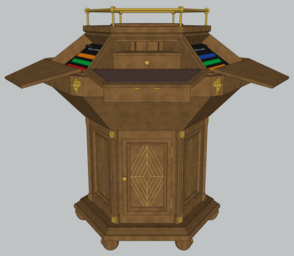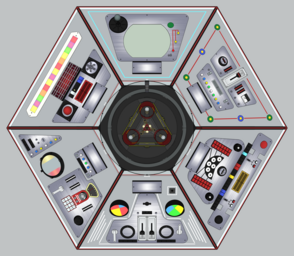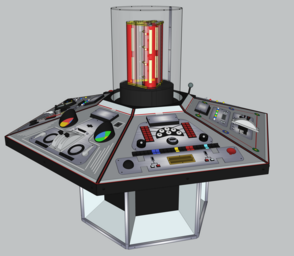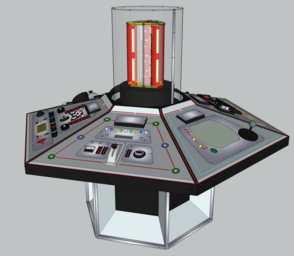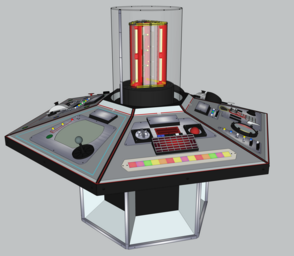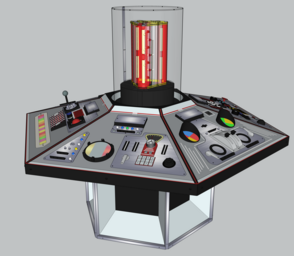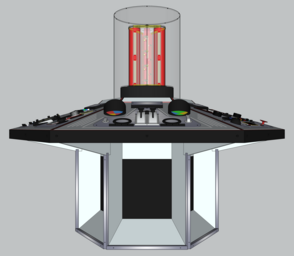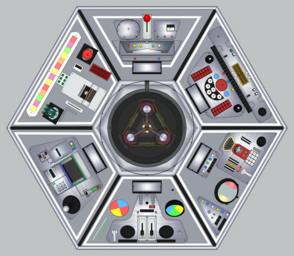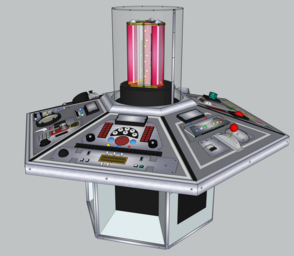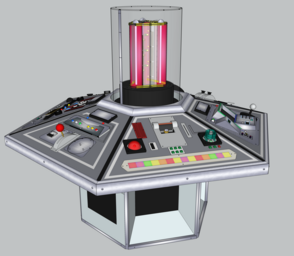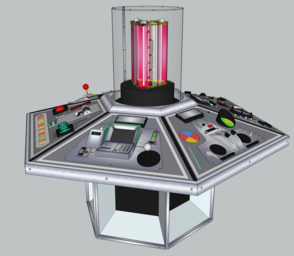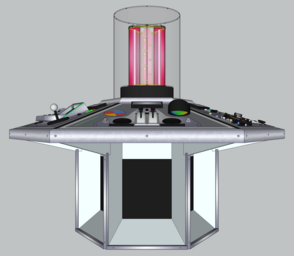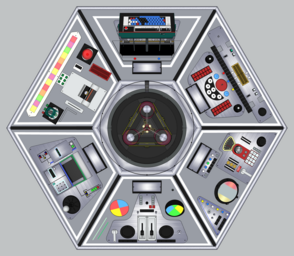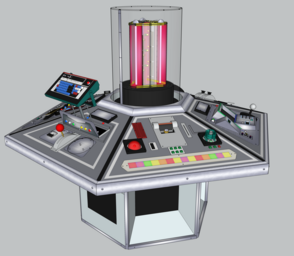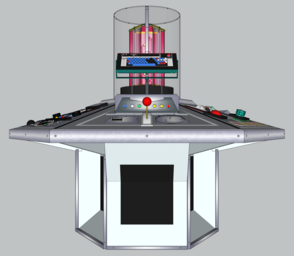TARDIS Console Fanpage
Various canonical console designs pictured. Right to left, top to bottom: Peter Brachacki (1963), Kenneth Sharp (1971), Christine Ruscoe (1975), Barry Newbery (1976), Season 16's iteration of Ruscoe's design, after major Season 15 revamp (1978), Season 19's iteration (1982), Season 20's final iteration (1983), Mike Kelt (1983), Richard Hudolin (1996), Ed Thomas with Matthew Savage (2005), Ed Thomas again (2010), Michael Pickwoad (2012), Arwel Wyn Jones (2018), Phil Sims (2023). Brachacki image colorized by Clayton Hickman.
Here are the products of my abiding appreciation for this design tradition. I dream in hexagons
Peter Brachacki Console (1963)
Model based on plans by Tony Farrell (with contributions from other TARDIS Builders users). This prop was built by Shawcraft Models, first appeared in An Unearthly Child (1963) and last appeared in Inferno (1970). Its initial design in the unaired pilot featured a more uniform control layout and some replaced features like transparent-handled levers. After a redesign for the first broadcast episode, its alien look had been toned down, and instead it appeared a mix between contemporary equipment interfaces and more timeless futurism. Its controls stayed relatively consistent, aside from increasing damage, occasional replacement of minor elements, and a few additions demanded by the script, until 1969. When it next appeared in The Ambassadors of Death (1970), outside the TARDIS itself, it was even further damaged. The entire rotating center assembly in the central column had been removed. In its last appearance (designer: Jeremy Davies), the center assembly was restored, the controls were spruced up, circuit board-like line decals were added, and the panel with the RADIATION meter was replaced with a new one with a large metal plate.
Kenneth Sharp Console (1971)
Model based on plans by Tony Farrell again. The second console prop was built by Magna Models and appeared between The Claws of Axos (1971) and Death to the Daleks (1974). It was designed to closely resemble the previous one (aside from the beautifully gaudy green central column) as of its last appearance, including the circuit-board lines and replaced panel. Like on the previous console, minor controls were occasionally replaced, and new controls suddenly appeared when the script required (including the iconic Time Ram meter and Extreme Emergency lever in 1972's The Time Monster, which Tim Gleeson was designer for). The prop's appearance changed more noticeably sooner in its lifespan than the last- all of the smaller meter decals visible in these images were later additions (mostly also in The Time Monster).
Christine Ruscoe Console (1975)
The Ruscoe design appeared in its original form in Season 13's Planet of Evil and Pyramids of Mars (1975), although it was made for the latter as they were filmed in reverse order from broadcast. It is believed to be built on the Sharp prop, and as far as I can tell from the dimensions that checks out. This design was fresher than Sharp's had been- it retained the frame, central column (made simpler and red) and a few controls, but the panel layouts have only a loose correspondence to the previous ones. The new components generally appeared scratch-built, or at least atypical for a real machine interface. As such it gained a degree of futurism the last design had aged out of, and probably remains more futuristic than any other classic console. However, there were far more dummy controls than before (most of the switches were just pieces of decorative wooden moulding) and the layout was generally less busy than the last. Between this design's two appearances, its panels switched places, something which would happen fairly often after its return in 1977 (i will not be bringing up the swaps explicitly in later descriptions. consult the linked image for a full panel position history)
Barry Newbery "Secondary" Console (1976)
NOTICE: this model can likely be improved. I may do that some time in the next few months-years.
Model based, with some adjustment, on Scarfwearer's plans, with much detail from Tony Farrell's partial plans elsewhere on the board. Season 14 saw for the first time a console room unconcerned with appearing futuristic. Instead, to match producer Philip Hinchliffe's literary, Gothic tone for the series, the set appeared a throwback to the previous century. Newbery's console, appearing between The Masque of Mandragora (1976) and The Robots of Death (1977), fit this vision, given the same faux-wooden finish as the rest of the room and (BBC budget) ornate detailing. The panels were given hinged covers, and one panel's space was occupied by a writing-desk. The controls were minimalist- in fact, there were apparently only 3 control panels built, one using round stickers in place of actual controls, and moved between slots as filming required. My model uses an early (no vermillion decals) and later version of the panel with the amber button row in back separately, along with a fictitious panel with the blue row in back plus decals, to fill all slots. The layout is roughly that of The Deadly Assassin plus The Hand of Fear Part Four stitched together.
Season 16 Console (circa 1978)
By a stricter standard, the show would average over one distinct console design per season between seasons 15 and 20 as designers and prop crews constantly made tweaks to Christine Ruscoe's base. Luckily most people probably don't have that strict of a standard, so I've tried to cut down the number and create a single more or less representative latter-Tom Baker-era console. This is roughly the prop's appearance in seasons 16 and 17, although it never looked exactly like this- I've mixed some elements on either side of a touchup. The red lines between panels and on the edge were actually removed four serials into Season 16 (The Androids of Tara), at which time most of the line decals on the panels and controls were added, along with the yellow centers to the disk decals on top right. A few other decals were added at the same time but I don't think they look very elegant so they aren't present here.
The most relevant console modifications to this point, and the designers credited for each:
- Season 15's The Invisible Enemy: grey paint job, removed panel dividing fins, added red line decals between panels and on top of central collar, reconfigured top left panel, lamps on top right panel replaced with disc decals with connecting lines, various other control tweaks. (Barry Newbery again)
- Season 16's The Ribos Operation: edge trim painted black, edge and collar painted very light grey, red line decal on edge, red line around central collar's top moved to its bottom, port on back right of bottom panel added. (Ken Ledsham)
- The Androids of Tara: see above (Valerie Warrender)
Season 19 Console (1982)
For Season 19, the console got another major change in style to go with new Doctor Peter Davison (I assume if you're still reading at this point you know how the show works). Rather than creating a somewhat ahisorical "representative version" as for the last iteration, I specifically modeled the console as seen in Castrovalva here (well, almost). I've also included the pop-out keyboard which is presumably still inside the console unused in that serial. Castrovalva's monitor setup, and that keyboard, are the peak of somewhat out-of-place, quickly-buried changes- and such changes are particularly representative of this era of console design.
Relevant (or later-superseded but hard to ignore) console modifications to this point:
- Season 16's The Pirate Planet: actually prior to The Androids of Tara. The left-hand sloped quadrant light shield is lost permanently (Jon Pusey credited but I am going to assume he wasn't responsible.)
- The Armageddon Factor: first appearance of the large red cap on the top panel's lever (Richard McManan-Smith credited, but he probably wasn't involved with something this minor)
- Season 17's The Horns of Nimon: black tape added around the metal plates at the back of each panel (Graeme Story credited, but again this may have been too minor for his purview)
- Season 18's State of Decay: the trim around the console is now metallic again. Top left panel rearranged to make way for a tape printer in the center, painted red-brown at this point (Christine Ruscoe again)
- Warrior's Gate: tube lamps in the central column replaced with 3 longer single tubes, now glowing pink. Silver hemispherical caps are added atop each pillar of the column. The metal star-dial on the top left panel is replaced with that teal plastic thing (Graeme Story)
- Logopolis: much change to the decals, including a second red line around the collar and some yellow and pale blue lines on the panels. The back plate on the top panel is redone and made hinged to allow a boxy keyboard (from a Honeywell Keytape system) to extend up from underneath it. (Malcolm Thornton)
- Season 19's Four to Doomsday: most old decals are removed and thicker white tape decals are added around the border of each panel. the central collar and edge are painted silver. Rectangular buttons are added in various places and the tape printer is repainted grey. Second and final use of the keyboard, although its extension mechanism will continue to be visible in the console's base. (Tony Burrough)
- Castrovalva: the bottom left panel is redone to include an actual monitor and (9-key...) keypad rather than a dummy screen. (Janet Budden)
designs copyright the british broadcasting corporation. plans (Brachacki and Sharp) and information used available on Tardis Builders, reference images from the same and tragicalhistorytour.com.



